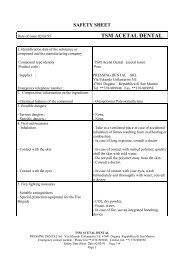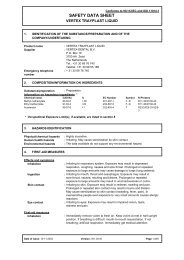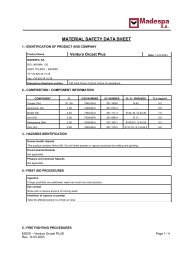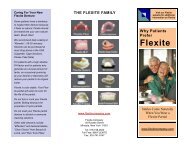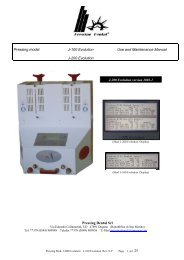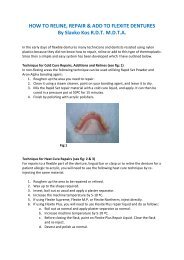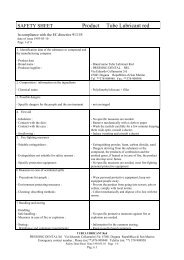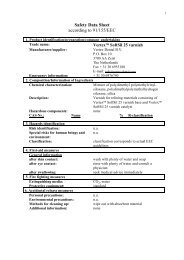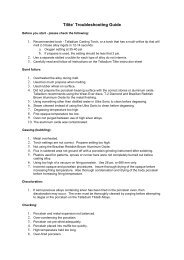ICAR - for conventional acrylic.pdf - Talladium UK
ICAR - for conventional acrylic.pdf - Talladium UK
ICAR - for conventional acrylic.pdf - Talladium UK
You also want an ePaper? Increase the reach of your titles
YUMPU automatically turns print PDFs into web optimized ePapers that Google loves.
I.C.A.R.<br />
instructions <strong>for</strong> use<br />
istruzioni per l’uso<br />
MANUFACTURER:<br />
Pressing Dental s.r.l - Via Edoardo Collamarini 5/d - 47891 Dogana (Repubblica di San Marino)<br />
I.CA.R. Device with J100 Pressing equipment<br />
The I.C.A.R device was created in order to guarantee a constant pressure during the polymerization<br />
stage of <strong>conventional</strong> <strong>acrylic</strong> resins.<br />
Technical phases:<br />
A) Once the total prosthesis has been waxed, the prosthesis must be placed in the base of the specific<br />
flask that accompanies the injection device.<br />
B) Once the mould is finished, the flask has to be prepared by placing the injection channels. Caution:<br />
the channel thickness must not exceed 2.5 mm, then it is necessary to isolate the flask by using a<br />
plaster / plaster insulator, it is advisable to place the steel adapter be<strong>for</strong>e casting the die, taking care<br />
to close the adapter’s hole with wax. (Fig. 1 / 2)<br />
To isolate the teeth from the plaster (in order to avoid any displacement during the injection phase),<br />
it is advisable to use an extra hard silicone or a silicone insulator be<strong>for</strong>e casting the die.<br />
Once the plaster has hardened put the flask in hot water to soften the wax, then open and clean it.<br />
C) After boiling out, isolate the teeth using a plaster/resin separtor.<br />
D) Close the flask and place the steel adapter once again (diagram 2) through the adequate thread at the<br />
injection mouth of the flask, then close the flask by tightening the screws.<br />
Cod. I.U. I.C.A.R. 01/0 ( GB ) 1<br />
Pressing Dental s.r.l. Via Edoardo Collamarini 5/d 47891 Dogana Repubblica di San Marino<br />
Tel. (Int. **378) 0549- 909948 Fax (Int. **378) 0549 - 909958 E-Mail pressingdental @omniway.sm
E) Preparation of the resin:<br />
The <strong>acrylic</strong> resin is prepared following the manufacturer’s instructions carefully; it is preferable to<br />
use the resins recommended <strong>for</strong> the injection process.<br />
While mixing it is advisable to bear in mind that a small additional quantity of resin will be needed<br />
<strong>for</strong> the injection channels. Once the powder and liquid have been well mixed in the mixing vessel, it<br />
is necessary to wait <strong>for</strong> the resin to reach its plastic stage (normally it is noted that the resin no longer<br />
makes filaments), at this point use a spatula to insert the resin into the aluminium cartridge J100 tube<br />
(piece 3), to facilitate this operation, cut into the cartridge (in the sealed part), this will allow the<br />
emission of air during the filling up phase.<br />
Once the filling up phase is over, place the Teflon plug (piece 4) and block the cartridge tip by using the device<br />
placed on the type J 100 equipment.<br />
Insert the cartridge into the adapter (pieces 2 – 3), then set the injection pressure slightly below 3<br />
atm., place the flask with the previously inserted device (pieces 1 – 2 – 3) and place all the items in<br />
the specific housing (caution: the oven must remain turned off), then tighten the manual press placed<br />
on the equipment and close the security door.<br />
F) Carry out the injection by pressing the (piston ↑) button.<br />
G) Wait about 6/7 minutes, then press the (piston ↓) button, loosen the manual press, and take the flask<br />
and the cartridge off.<br />
H) Once the flask has been taken off, make sure there is no resin within the adapter piece 2 (apart from<br />
the hole), then place the manual injector (piece 5), the injector must be tightened until the tally mark<br />
on the piston is visible. (Ex. 6)<br />
I) Insert the flask into water to polymerize the resin (as indicated in the manufacturer’s instructions);<br />
take care that the water level does not exceed the upper screws of the flask, as this would advance the<br />
polymerization of the resin along the injection channel, thereby preventing its flow.<br />
Once the injection and polymerization phases are over, wait until the flask has reached room temperature,<br />
unscrew the manual injector (diagram 5), unscrew the blocking screws of the flask and open the flask, then<br />
proceed to finish the prosthesis following <strong>conventional</strong> methods.<br />
1<br />
2 3 4 5 6<br />
Cod. I.U. I.C.A.R. 01/0 ( GB ) 2<br />
Pressing Dental s.r.l. Via Edoardo Collamarini 5/d 47891 Dogana Repubblica di San Marino<br />
Tel. (Int. **378) 0549- 909948 Fax (Int. **378) 0549 - 909958 E-Mail pressingdental @omniway.sm



